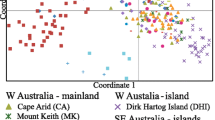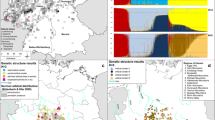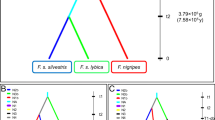Abstract
Madagascar does not have native wild felid species; however, distinct populations of free-ranging “forest cats” of unknown species are known throughout the island, including at Ankarafantsika National Park, Bezà Mahafaly Special Reserve, Makira Natural Park and the Masoala peninsula. Malagasy “forest cats” are commonly considered invasive lemur predators and competitors with endemic carnivores as well as a nuisance exotic species that kill poultry. These cats may be descendants of African wildcats, European wildcats and/or domestic cats; however, no research on their genetic origin has been published. To determine their taxonomic status, genetic data from short tandem repeat markers was assessed for three wild-caught “forest cats” from the Bezà Mahafaly Special Reserve (BMSR) and 27 “forest cats” from Ankarafantsika National Park. Bayesian analyses comparing the Malagasy “forest cats” to approximately 1900 domestic and wildcat sub-species suggest the Malagasy cats are descendents of domestic cats from the Arabian Sea region, including the islands of Lamu and Pate, Dubai, Kuwait and Oman. Additional genetic influences may descend from India and Pakistan. Combined with cultural and historical information, these data suggest that these felid populations are likely descendents from cats that immigrated to the island on trade ships, particularly along early Arab trade routes.



Similar content being viewed by others
References
Barendse RJ (2002) The Arabian seas: the Indian Ocean world of the seventeenth century. Routledge, New York
Barycka E (2007) Evolution and systematics of the feliform Carnivora. Mammal 72:257–282
Beaumont M, Barratt EM, Gottelli D, Kitchener AC, Daniels MJ, Prichard JK, Bruford MW (2001) Genetic diversity and introgression in the Scottish wildcat. Mol Ecol 10:319–336
Borgerson C (2013) The fitoaty: an unidentified carnivoran species from the Masoala peninsula of Madagascar. Madag Conserv Dev 8:81–85
Brockman DK, Godfrey LR, Dollar LJ, Ratsirarson J (2008) Evidence of invasive Felis silvestris predation on Propithecus verreauxi at Beza Mahafaly Special Reserve. Madag Int J Primatol 29:135–152
Buffon GLL (1766) Comte de histoire naturelle, générale et particulière, avec la description du cabinet du Roi. Imprimerie Royale, Paris
Campbell G (2012) David Griffiths and the missionary “History of Madagascar”. Brill, Boston
Campbell KJ, Harper G, Algar D, Hanson CC, Keitt BS, Robinson S (2011) In: Ceitch CR, Clout MN, Towns DR (eds) Island invasives: eradication and management. IUCN, Gland, pp 37–46
Czaja R, Wills A, Hanitriniaina S, Reuter KE, Sewell BJ (2015) Consumption of domestic cat in Madagascar: frequency, purpose, and health implications. Anthrozoös 28:469482
de La Beaujardière J (2017) Malagasy dictionary and encyclopedia of Madagascar. https://malagasyword.org
Dollar LJ (2006) Morphometrics, diet, and conservation of Cryptoprocta ferox. Duke University
Dollar LJ, Pomerantz J, Rahajanirina LP (2007) Carnivores of Madagascar: earthwatch expedition briefing and forms. Earthwatch Institute
Driscoll CA, Menotti-Raymond M, Roca AL, Hupe K, Johnson WE, Geffens E, Harley EH, Delibes M, Pontier D, Kitchener AD, Yamaguchi N, O’Brien SJ, Macdonald DW (2007) The near eastern origin of cat domestication. Science 317:519–523
Driscoll C, Yamaguchi Y, O’Brien S, Macdonald DW (2011) A suite of genetic markers useful in assessing wildcat (Felis silvestris ssp.)—domestic cat (Felis silvestris catus) admixture. J Hered 102(Suppl 1):S87–S90
Eizirik E, Yuhki N, Johnson WE, Menotti-Raymond M, Hannah SS, O'Brien SJ (2003) Molecular genetics and evolution of melanism in the cat family. Curr Biol 13:448–453
Eizirik E, David VA, Buckley-Beason V, Roelke ME, Schaffer AA, Hannah SS, Narfstrom K, O'Brien SJ, Menotti-Raymond M (2010) Defining and mapping mammalian coat pattern genes: multiple genomic regions implicated in domestic cat stripes and spots. Genetics 184:267–275
Esoavelomandroso F (1984) General history of Africa IV: Africa from the twelfth to the sixteenty century, D.T Niane edn. University of California Press, Berkeley
Estoup A, Guillemaud T (2010) Reconstructing routes of invasion using genetic data: why, how and so what? Mol Ecol 19:4113–4130
Estoup A, Ravigné V, Hufbauer R, Vitalis R, Gautier M, Faco B (2016) Is there a genetic paradox of biological invasion? Annu Rev Ecol Evol Syst 47:51–72
Evanno G, Regnaut S, Goude J (2005) Detecting the number of clusters of individuals using the software STRUCTURE: a simulation study. Mol Ecol 14(2611):2620
Farris ZJ, Gerber BD, Karpanty S, Murphy A, Andrianjakarivelo V, Ratelolahy F, Kelly MJ (2015) Activity patterns of Madagascar's carnivore community. J Zool 296:45–57. https://doi.org/10.1111/jzo.12216
Farris ZJ, Boone HM, Karpanty S, Murphy A, Ratelolahy F, Andrianjakarivelo V, Kelly M (2016a) Feral cats and the fitoaty: first population assessment of the black forest cat in Madagascar’s rainforests. J Mammal 97:518–525
Farris ZJ, Kelly MJ, Karpanty S, Murph A, Ratelolahy F, Andrianjakarivelo V, Holmes C (2016b) The times they are a changing: multi-year surveys reveal exotics replace native carnivores at a Madagascar rainforest site. Biol Conserv 206:320–328
Farris ZJ, Kelly MJ, Karpanty S, Ratelolahy F (2016c) Patterns of spatial co-occurrence among native and exotic carnivores in north-eastern Madagascar. Anim Conserv 19:189–198
Farris ZJ, Gerber BD, Valenta K, Rafaliarison R, Razafimahaimodison JC, Larney E, Rajaonarivelo T, Randriana Z, Wright PC, Chapman CA (2017) Threats to a rainforest carnivore community: a multi–year assessment of occupancy and co–occurrence in Madagascar. Biol Conserv 210:116–124
Flacourt E (1658) Histoire de la Grande Isle Madagascar composée par le Sieur de Flacourt. Paris: Chez G. de Lvyne.
Garbutt N (2007) Mammals of Madagascar: a complete guide. Yale University Press, New Haven
Gerber BD, Karpanty SM, Randrianantenaina J (2012) The impact of forest logging and fragmentation on carnivore species composition, density and occupancy in Madagascar’s rainforests. Oryx 46:414–422
GoncharenkoZyat’kov GGSA, Lysenko LS (2010) Genetic structure and the level of differentiation in Felis catus populations of the European continent. Lysenko Doklady Akademii Nauk 431:135–138
Goodman SM, Benstead JP (2003) The natural history of Madagascar. University of Chicago Press, Chicago
Grahn RA, Lemesch BM, Millon LV, Matise T, Rogers QR, Morris JG, Fretwell N, Bailey SJ, Batt RM, Lyons LA (2005) Localizing the X-linked orange colour phenotype using feline resource families. Anim Genet 36:67–70
Ishida Y, David VA, Eizirik E, Schaffer AA, Neelam BA, Roelke ME, Hannah SS, O'Brien SJ, Menotti-Raymond M (2006) A homozygous single-base deletion in MLPH causes the dilute coat color phenotype in the domestic cat. Genomics 88:698–705
Jakobsson M, Rosenberg NA (2007) CLUMPP: a cluster matching and permutation program for dealing with label switching and multimodality in analysis of population structure. Bioinformatics 23:1801–1806
Kerr R (1792) The animal kingdom or zoological system of the celebrated Sir Charles Linnaeus: class I. mammalia (class II. the birds): containing a complete systematic description, being a translation of that part of the Systema Naturae: Murray
Koch K, Algar D, Searle JB, Pfenninger M, Schwenk K (2015) The voyage to Terra Australis: human-mediated dispersal of cats. BMC Evol Biol 15:262. https://doi.org/10.1186/s12862-015-0542-7
Koch K, Algar D, Schwenk K (2016) Feral cat globetrotters: genetic traces of historical human-mediated dispersal. Ecol Evol 6:5321–5332
Kotschwar LM, Gerber BD, Karpanty SM, Justin S, Rabenahy FN (2015) Assessing carnivore distribution from local knowledge across a human-dominated landscape in central-southeastern Madagascar. Anim Conserv 18:82–91
Krause DW, Hartman JH, Wells NA (1997) Late Cretaceous vertebrates from Madagascar: implications for biotic change in deep time. Smithsonian Institution Press, Washington
Kurushima JD (2011) Genetic analysis of domestication patterns in the cat (Felis catus): worldwide population structure, and human-mediated breeding patterns both modern and ancient. PhD dissertation, In: Genetics, p. 148. University of California, Davis, ProQuest Dissertations and Theses. (Publication No. AAT 11271)
Kurushima JD, Lipinski MJ, Gandolfi B, Froenicke L, Grahn JC, Grahn RA, Lyons LA (2013) Variation of cats under domestication: genetic assignment of domestic cats to breeds and worldwide random-bred populations. Anim Genet 44:311–324
Larsen PM (1997) A cultural politics of bedchamber construction and progressive dining in Antananarivo: ritual inversions during the Fandroana of 1817. J Relig Africa 27:239–269
Lipinski MJ, Froenicke L, Baysac KC, Billings NC, Leutenegge CM, Levy AM, Longeri M, Niini T, Ozpinar H, Slate MR, Pedersen NC, Lyons LA (2008) The ascent of cat breeds: genetic evaluations of breeds and worldwide random-bred populations. Genomics 91:12–21
Mann GKH, Long P, Rakotondrapararany F, The Seing S, Gandola R (2015) First record of fossa Cryptoprocta ferox in Mariarano forest, Madagascar. Small Anim Conserv 52 & 53:45–55
Mattucci F, Oliveira R, Lyons LA, Alve PC, Randi E (2016) European wildcat populations are subdivided into five main biogeographic groups: consequences of Pleistocene climate changes or recent anthropogenic fragmentation? Ecol Evol 6:3–22
McCartney MA, Mallez S, Gohl DM (2019) Genome projects in invasion biology. Cons Gen 20:1201–1222
Medina FM, Bonnaud E, Vidal E, Tershy FR, Savaleta ES, Donlan C, Keitt BS, Le Corre M, Horwath SV, Nogales M (2011) A global review of the impacts of invasive cats on island endangered vertebrates. Glob Change Biol 17:3503–3510
Merson SD, Dollar LJ, Tan CKW, MacDonald DW (2019) Effects of habitat alteration and disturbance by humans and exotic species on fosa Cryptoprocta ferox occupancy in Madagascar's deciduous forests. Oryx. https://doi.org/10.1017/S003060531800100X
Montague MJ, Li G, Gandolfi B, Khan R, Aken BL, Searle SMJ, Minx P, Hiller LW, Koboldt DC, Davis BW, Driscoll C, Barr CS, Blackistone K, Quilex J, Lorente-Galdos B, Marques-Bonet T, Alkan C, Thomas GWC, Hahn MW, Menottie-Raymond MM, O'Brien SJ, Wilson RK, Lyons LA, Murphy WJ, Warren WC (2014) Comparative analysis of the domestic cat genome reveals genetic signatures underlying feling biology and domestication. PNAS 111:17230–17235
Murphy A, Kelly MJ, Karpanty SM, Andrianjakarivelo V, Farris ZJ (2018) Using camera traps to investigate spatial co-occurrence between exotic predators and native prey species: a case study from northeastern Madagascar. J Zool 307:265–273
Oliveira R, Randi E, Mattucci F, Kurushima JD, Lyons LA, Alves PC (2015) Toward a genome-wide approach for detecting hybrids: informative SNPs to detect introgression between domestic cats and European wildcats (Felis silvestris). Heredity 115:195–205
Pocock RI (1951) Catalogue of the Genus Felis. Jarrold and Sons Ltd, Norwich
Pritchard JK, Stephens M, Donnelly P (2000) Inference of population structure using multilocus genotype data. Genetics 155:945–959
Radimilahy C (1998) Mahilaka: An archaeological investigation of an early town in Northwestern Madagascar. In: Studies in African archaeology. Poznan: Poznan Archaeological Museum
Ragni B, Possenti M (1996) Variability of coat-colour and markings system in Felis Silvestris. Ital J Zool 63:285–292
Raia P, Meiri S (2006) The island rule in large mammals: paleontology meets ecology. Evol Int J Org Evol 60:1731–1742
Randi E, Pierpaoli M, Beaumont M, Ragni B, Sforzi A (2001) Genetic identification of wild and domestic cats (Felis silvestris) and their hybrids using Bayesian clustering methods. Mol Biol Evol 18:1679–1693
Richardson J (1885) A new Malagasy-English dictionary. The London Missionary Society, Antananarivo
Ruud J (1960) Taboo: a study of Malagasy customs and beliefs. Oslo University Press, Oslo
Sauther M, Strinden M, Youssouf Jacky IA, Cuozzo F, Boeken D (2015) Not just lemurs on the menu: assessment of feeding habits and general prey preferences among introduced and endemic predators at the Beza Mahafaly Special reserve, Madagascar using scat sampling. Folia Primatol 86:352. https://doi.org/10.1159/000435825
Schmidt-Kuntzel A, Nelson G, Davi VA, Schaffer AA, Eizirik E, Roelke ME, Kehler JS, Hannah SS, O'Brie SJ, Menotti-Raymond M (2009) Linkage map and the sex-linked orange locus-mapping of Orange, multiple origins, and epistasis over non-Agouti. Genetics 181:1415–1425
Schneider A, David VA, Johnson WE, O'Brien SJ, Barsh GS, Menotti-Raymond M, Eizirik E (2012) How the leopard hides its spots: SIP mutations and melanism in wild cats. PLoS ONE 7:e50386. https://doi.org/10.1371/journal.pone.0050386
Schneider A, Henegar C, Day K, Absher D, Napolitano C, Silveira L, Davi VA, O'Brien SJ, Menotti-Raymond M, Barsh GS, Eizirik E (2015) Recurrent evolution of melanism in South American felids. PLoS Genet 11:e1004892. https://doi.org/10.1371/journal.pgen.1005126
Spencer PB, Yurchenko AA, David V, Scott R, Koepfli K, Driscoll C, O'Brien SJ, Menotti-Raymond M (2016) The population origins and expansion of feral cats in Australia. J Hered 107:104–114
Tucker B (2004) Giving, scrounging, hiding, and selling: minimal food sharing among Mikea of Madagascar. Socioeconomic aspects of human behavioral ecology. Res Econ Anthropol 23:45–68
Tucker B (2007) Applying behavioral ecology and behavioral economics to conservation and development planning: an example from the Mikea Forest, Madagascar. Hum Nat 18:190
Vaovao A (1973) Diksionera: Malagasy-Englisy. Trano Printy Loterana, Antananarivo
Acknowledgements
Funding was provided by the University of Colorado-Boulder, Iowa State University, the Ensminger Fund, the International Primatological Society Conservation Grant, The Margot March Biodiversity Foundation, and Primate Conservation Incorporated. Funding for genetic analyses was supplied in part by the University of Missouri, College of Veterinary Medicine Gilbreath McLorn Endowment, National Geographic Expedition Grant (EC0360-07), National Institutes of Health—National Center for Research Resources (NCRR) Grant R24 RR016094R24/OD010928, the University of California—Davis, Center for Companion Animal Health, the Winn Feline Foundation (W10-014), a gift from Illumina, Inc. (LAL), and the University of California—Davis Wildlife Health Fellowship (JDK). ISPRA support the Laboratory of Conservation Genetics for some of the European wildcats genetic data. We kindly thank all the people, particularly Julie Feinstein and the Ambrose Monell Collection at American Museum of Natural History, for the tissues and who have contributed to the collection of cat samples. We thank the members of the BMSR ecological monitoring team and Ms. Jenifer Ness for their research assistance and we thank ANGAP for their permission to conduct research at BMSR.
Author information
Authors and Affiliations
Corresponding author
Additional information
Publisher's Note
Springer Nature remains neutral with regard to jurisdictional claims in published maps and institutional affiliations.
Electronic supplementary material
Below is the link to the electronic supplementary material.
10592_2020_1261_MOESM2_ESM.eps
Supplementary file2—Supplementary Figure 1 The delta K of the Baysian cluster analysis of the Madagascar “forest cats”, worldwide random bred cats and wildcat subspecies. (EPS 171653 kb)
Rights and permissions
About this article
Cite this article
Sauther, M.L., Bertolini, F., Dollar, L.J. et al. Taxonomic identification of Madagascar’s free-ranging “forest cats”. Conserv Genet 21, 443–451 (2020). https://doi.org/10.1007/s10592-020-01261-x
Received:
Accepted:
Published:
Issue Date:
DOI: https://doi.org/10.1007/s10592-020-01261-x




